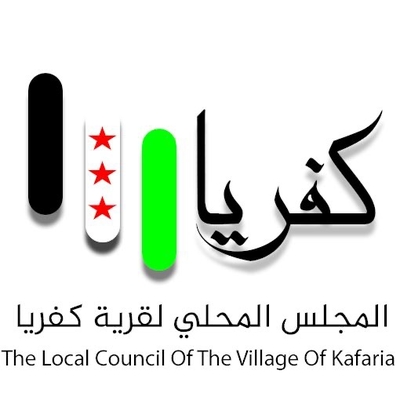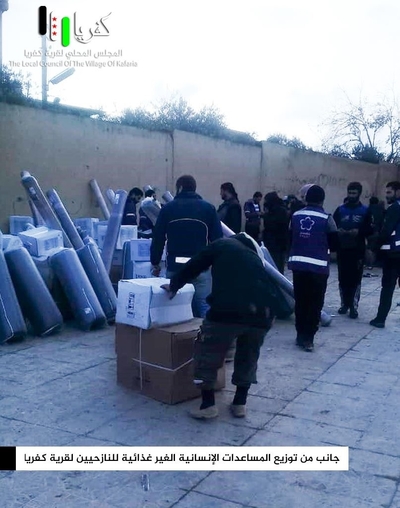Kafariya is a village located in north Idlib countryside. Like the neighbouring village of al-Fu'a (also see here), the original inhabitants were Syrian Shi'a who were evacuated entirely from the village by summer 2018. Since that time, Kafariya (like al-Fu'a) has been resettled primarily by Syrian IDPs from other parts of the country. Currently, a local council for Kafariya affiliated with the Hay'at Tahrir al-Sham-backed Salvation Government is administering civilian affairs in the village.
To learn more about the humanitarian situation in Kafariya, I conducted an interview with Abu Abd al-Salam, who is the media guy for the current Kafariya local council. For NGOs that would like to contact him regarding provision of humanitarian aid in light of the current situation, here is his number: +963 968 611 296. To email the current Kafariya local council: [email protected].
This interview was conducted on 20 January 2020. It is slightly edited and condensed for clarity. Any parenthetical insertions in square brackets are my own.

Q: What is the number of inhabitants in the locality of Kafariya currently? And from which areas are most of them?
A: The number of inhabitants of the village of Kafariya as a general total is 4500-5000 people. They are divided [in origin] between a number of regions: north Hama countryside, Homs, East and West Ghouta, and Idlib province. And now in the recent displacement there have been added to them displaced people from Ma'arat al-Nu'man and its countryside areas. With the survey of the new displaced people the number of inhabitants of the village reaches more than 6000 people.
Q: Can you talk a little about the sufferings of the people of the village in general?
A: The forms of suffering we are suffering in the village of Kafariya are extremely numerous, with the almost complete absence of humanitarian and governmental organisations. Among the most important of the sufferings present among us is the absence of services projects in the village, like a project to pump drinking water and a project to collect garbage from the streets because among us the scenes are catastrophic, not to mention the destruction of the infrastructure in the village. For example we have problems in the sewage and problems in the roads, most of which have fragmentation and are not paved with asphalt. And there are many piles of ruin that until today no one has spoken of removing. These words concern the services projects. As for the educational and relief projects they are virtually dead.
Q: Is there electricity from generators in the village?
A: There is only one generator and no others. And most of the people are not subscribed to it because of the expensiveness of the prices. And there are people with solar panels.
Q: For how many hours is the generator operated?
A: 1 hour and 45 minutes and the ampere costs 3500 Syrian pounds.
Q: So have the hours of operation been reduced because of the expensiveness of the dollar?
A: Exactly, because of the expensiveness of mazout with regards to exchange rate.
Q: Why are the aid organisations absent from Kafariya?
A: Very good question. As you know Kafariya's original inhabitants left, right?
Q: Yes.
A: And most of those who received the village after them are the factions. At the time the factions received the village, they divided it into multiple sectors and brought to reside in it military personnel people, but this state of affairs did not last long, because most of those of the factions who dwelt in it: some left for Afrin, like the al-Ahrar group and even those of the Hay'a [Hay'at Tahrir al-Sham], a great portion of them moved to another area because of the components of life in it are extremely weak. And only the group of people whose material state of affairs is extremely weak have remained. And it is as a region with regards to the international community seized militarily and its people remain victims and have been displaced, so how will they help the people who have seized it???? Of course I am speaking about the organisations present on the outside.
Q: But now most of the people in the village are civilians?
A: Yes, there is a very small group of military personnel.
Q: And which factions seized the village? The Hay'a and Jaysh al-Ahrar and Faylaq al-Sham? I mean when the village was divided up.
A: Yes. But brother the village was exposed last year to bombing by aircraft, if you remember.
Q: Yes I remember.
A: After that most of the factions left and went, because it became well-known this would be the first place to be bombed, so most of the people who remained in the village are originally displaced people from Homs and al-Sham [Damascus], and a short time after it people from north Hama countryside came as displaced persons to it at the time of military operations against the Hama countryside areas. And currently a number of the inhabitants of Ma'arat al-Nu'man and its countryside areas have come to it as displaced persons. So 95% of those present are civilians.
Q: When was the current local council formed?
A: The local council for the village was formed around a year ago but nothing was provided and it did not offer any service, therefore it has been replaced more than three times. And today the formation I am working with has been around for a month only, from the beginning of the presence of our page on Facebook. And praise be to God the situation has improved more or less even if only in a simple sense.
Q: The current council is affiliated with the Salvation Government like the prior councils?
A: Yes affiliated with it, but we are not seeing services being offered to us like the rest of the councils.
Q: How has the situation improved since the formation of the new council?
A: I don't know if you saw on the page that some organisation came and distributed relief baskets to the newly displaced people and to small numbers of the inhabitants of the village. I am speaking about offering of aid. As for at the level of services projects, there are none.

Q: What is the number of members of the council and what are its main offices?
A: The number of main members is nine. And there are delegates from each group like a delegate for the people of al-Sham and a delegate for the people of Homs. [The main offices] are the office of the head of the council, the services office, the survey office and the financial office.
Q: In the village of al-Fu'a I saw that there has been a problem between the local council and a 'local council- Jaysh al-Ahrar sector'. There is none of this sort of thing in the village of Kafariya?
A: No we don't have this sort of thing, and the council is united for all without factionalism.
Q: Can you talk a little about the impact of the rise of the price of the dollar on life in Kafariya?
A: Regarding Kafariya, there has been no impact in the rise of the exchange rate except the increase of expensiveness upon the citizens, because in the village there are no employees receiving their pay in the dollar. Those who work, their work is as ordinary workers taking their pay in the Syrian pound, so the rise of the dollar has been a catastrophe for the inhabitants of the village and greatly increased the suffering of the people.
Q: So will you use the Turkish lira instead of the Syrian pound?
A: We cannot issue such a decision as a local council for the village: it requires people to be much more proactive.

